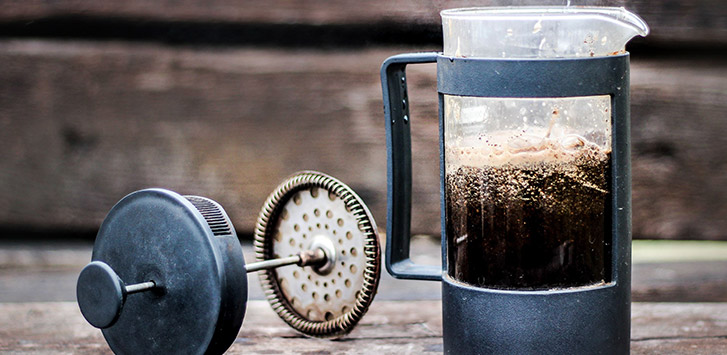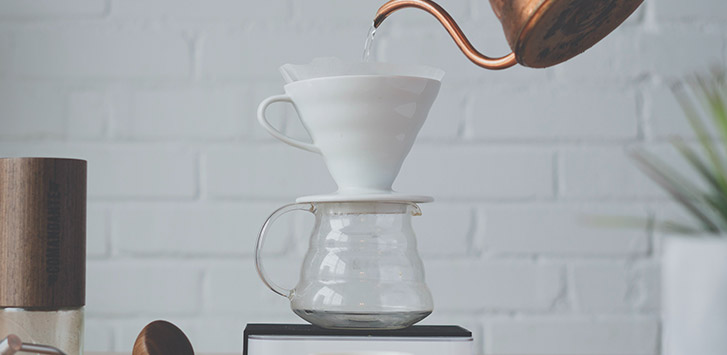A kettle of hot water, a paper filter, and a bunch of coffee grounds walk into a bar. The next thing you know, they’re in a hot debate about whether immersion brewing is better than drip brewing. One of the other customers overhears and is too nervous to admit that they don’t actually know the difference. Fortunately, we’re working through this right now, and that will never be you.
What Is Immersion Brewing?

Immersion brewing, as the name indicates, involves immersing coffee grounds in hot water. Then, you let the grounds saturate in the water.
When the time is up, filter the grounds out of the finished coffee. Depending on the brewer, you can do this multiple different ways. Immersion brewing includes both the famous French press and AeroPress.
The best part of immersion brewing is how easy it is. Most immersion brewers involve mixing the water and grounds, waiting a specific amount of time, and then filtering the coffee. You control the amount of grounds and water, the length of the saturation, and the temperature.
Beyond that, the brewer does all the hard work.
Regarding the flavor, immersion brewing creates a full, well-rounded flavor profile. This is due to the amount of time the water is in contact with the coffee grounds.
Before you try immersion brewing, you should know a few things first. While it's an easier brewing method, there is some fiddling required to get the grind size right. Additionally, you have to make sure that you’re timing the brew correctly, or the coffee will be oversaturated.
Finally, if you don’t enjoy heavier coffees, then this is not the approach for you.
What Is Drip Brewing?

Odds are, if you’ve spent time in the coffee community, you’ve heard the term pour over. To make pour over, you put coffee grounds in a filter and pour hot water in concentric circles over them. When you’re done, you have a lovely pot of coffee waiting for you.
Pour over brewing falls under the larger category of drip brewing, a category defined by the use of gravity in brewing. Also falling under this category is batch brewing, like with the Behmor Brazen Plus 30. As opposed to pour over, with drip coffee, you don't manually pour the water over the coffee grounds. This removes one layer of variability from the process.
There are a lot of positive aspects to drip brewing. This method does a fantastic job of bringing out each flavor in even the most complex of grounds.
There’s a lot of customization in this area as well. Different coffee brewers for drip brewing can highlight different flavors in the bean. Aspects like filter paper thickness and exit holes change the time and way that the water interacts with the grounds.
As a final bonus, drip brewing requires less coffee grounds than immersion brewing. This lets you make more coffee with any batch of coffee beans.
Similar to immersion brewing, drip brewing still has some downsides. Drip brewing provides a lot of customization options for your coffee’s flavor. This means that there’s a lot of different ways that the coffee can come out. Sometimes, without even realizing something was done differently, you can get two vastly varying flavors.
Two specific errors lend themselves to this problem: channeling and temperature instability. Channeling refers to when water travels the same path between the grounds, meaning that the flavor is ultimately uneven. To solve this, make sure you evenly grind your coffee beans and evenly pour water over them.
Temperature instability refers to the temperature of the water changing and therefore affecting its interaction with the grounds. Water cooling too quickly is a prime example of this. This can be fixed simply by being mindful of timing regarding heating and pouring.
What Makes Immersion Brewing Different Than Drip Brewing?
Immersion brewing and drip brewing are quite different. While both use filters, water, and coffee grounds, they ultimately provide a substantially different product. Knowing the difference will help you to find the cup of coffee that you’re most excited about.
The key to immersion brewing is timing. You add the water and the grounds, and you wait. By allowing the grounds to sit in the water, you give the coffee longer to build out its flavor. This means that, for a consistent, full cup of coffee, immersion brewing should be your go-to.
The key to drip brewing is the pour. While this can be done for you with various coffee machines, doing it yourself gives you the most control.
This is where drip brew shines: customization. Each step of the process is yours to guide. The result will highlight the different flavors in the grounds and give you a much lighter tone.
The best part of this is that you have a choice between the two. Whether you like full bodied coffee or a lighter brew, you have great options available to you. And now that you know the difference between the two, you’re ready to go make a great cup of coffee!